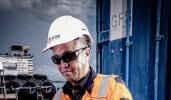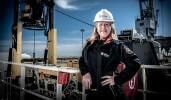24 September 2015
The Polarled Pipeline
In 2015, Statoil and Allseas were the first offshore industry leaders to install a pipeline across the Arctic Circle. The Polarled pipeline stretches 480 kilometres from Nyhamna in the county of Møre og Romsdal to the Aasta Hansteen platform in the Norwegian Sea.
A change of scenery
In 2012, surveyor Fernando de la Garza began working through Atlas Professionals offshore Survey and Construction office based in Newquay. After eight years working as a land surveyor, Fernando decided to have a change of scenery. Through a family member, Fernando learnt about the benefits of the offshore industry, travelling the world and gaining new opportunities in the survey market.
“I have never had any regrets in changing my career from onshore to offshore,” says Fernando, “I was looking for a change in my life and the offshore industry gave that to me. I studied Land Surveying and GIS at Texas State University. After working onshore I finally got my chance to work offshore with UTEC Offshore Survey.”
Allseas in the Arctic
Due to its severe climate, the Arctic Circle is one of the most remote locations on Earth and one of the most unexplored areas for the offshore industry. Although Fernando encountered minor problems in the Arctic, the challenges of subsea Norway were more unpredictable. “Norway itself is a very challenging environment to work in. This is because of its subsea topography and its small weather windows. The environment isn’t very welcoming to subsea structures or pipelines to begin with.”
For the last three years, Fernando has built a long-standing relationship with Dutch-Swiss Company Allseas, he explains how he came upon the Polarled project. “I’ve been working with Allseas for the last two years, on their pipelaying vessel, the Solitaire. There had been a lot of talk on the boat about Statoil and Allseas venturing into the Arctic Circle with the Polarled pipeline, and the known challenges that they would be facing going into the Arctic, which the vessel encountered on the Orman Lange Project for Statoil. From my previous experience with the company I was hired as a senior surveyor for the project.”
As senior surveyor, Fernando’s task is to follow the engineering design route using the GPS and referencing systems to guide the pipeline along the route. “As part of the survey team our task is to oversee and maintain the ship’s positioning and reference systems when installing the pipeline. We also liaise with the support vessel which is doing the touch down monitoring with the ROVs. This is an integral part of the construction support as this identifies the suitable locations for us to place the structures.”
As the pipeline extends further into the Arctic, in close proximity to the North Pole, the Solitaire has had to overcome some communication and software issues. “Sometimes our communications and systems can be affected by issues like solar events and magnetic effects. We have encountered a few issues with the GPS systems however; Allseas have fail safes in place to ensure that the progress of production is not affected.”
A Sensitive Environment
With the Arctic summer temperature at -10 °C, Allseas have taken into consideration all the risks that may occur while working in this environment, especially the mitigation of harm to the environment and marine wildlife in the Arctic. “The Arctic is obviously a very sensitive environment, both Statoil and Allseas cautioned off the marine and coral sensitive areas identified in pre-lay surveys and we did everything in our power to ensure that no harm would come to the environment.”
Fernando shares his thoughts on the installation of pipelines into the Arctic, “Undoubtedly, pipelines are going to go further into the Arctic. We’ve seen Shell doing exploratory work around the Arctic. I believe that any company who decides to go into production here will put all the research and systems in place to ensure that there is no negative harm to the environment.”
Problem Solving is the Number One Skill
“My advice to a trainee would be to absorb as much as possible and ask as many questions as possible; even if you’re working in a different department on the vessel ask questions whilst your onboard. Problem solving is the number one skill in this industry, if you can think on your feet you can become a dependable and crucial team player.”
.png)
.png)


